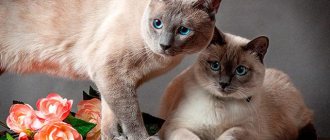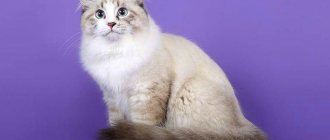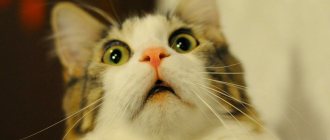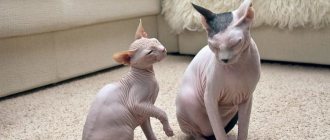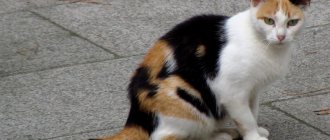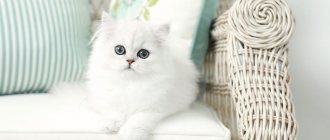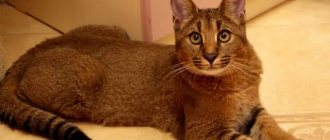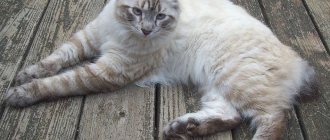/ Cats / Cat breeds / Foreign White cat breed
0
2165
Article rating
Foreign White was the result of crossing a Siamese and a white cat. Unlike other whitish varieties, Foreign White cats are not albino and do not have hearing problems. Their homeland is England: in 1962, experts first bred this breed. The price of cats ranges from 5 to 15 thousand rubles. Today, breeding is carried out by breeders who breed cats of Oriental and Siamese breeds. There is a Foreign White nursery in Moscow and other large cities.
Foreign White
Foreign White cat breed
Foreign White was the result of crossing a Siamese and a white cat. Unlike other whitish varieties, Foreign White cats are not albino and do not have hearing problems. Their homeland is England: in 1962, experts first bred this breed. The price of cats ranges from 5 to 15 thousand rubles. Today, breeding is carried out by breeders who breed cats of Oriental and Siamese breeds. There is a Foreign White nursery in Moscow and other large cities.
Possible diseases
This breed is characterized by good health, and practically has no tendency to deafness - this is extremely rare. However, due to inbreeding, the following complications can sometimes occur:
- Mammary tumors are the most common tumors in cats, accounting for 12% of all tumors in cats and 17% of tumors in foreign whites.
- congenital peripheral vestibular disease. Clinical signs develop at 3–4 weeks of age, and there is usually an increase in clinical signs at 3–4 months of age. Clinical signs include head tilt, imbalance, nystagmus (rapid horizontal or rotational eye movements), and ataxia (uncoordinated walking).
- Hydrocephalus - Hydrocephalus is the most common abnormal brain disorder. This may have genetic roots.
We recommend the article: Description of the Japanese Bobtail breed
Description of the breed
Adults weigh on average 3-5 kg. A distinctive feature in appearance is the head. On a slender and elongated neck, a triangular head looks quite proportional. The chin and forehead have pronounced features. The ears are elongated and also look like triangles. The eyes are shaped like almonds and are located at an angle, with a deep gaze. The breed is slender and fit. The hind legs are slightly longer than the front legs. Tapered tail without creases.
The coat is smooth, short, and lies close to the body. This breed is easy to recognize by its snow-white fur and blue eyes. The nose and paw pads are pink. If, when breeding kittens, at least one parent is white, then the cubs will also be pure white. If both parents are white, then half of the kittens will be white, and the other half will have a blue tint. You can look at Foreign White cats in more detail in the photo or video.
How to get a kitten
Foreign White kittens are offered for sale when they are 4 months old. In order not to buy a purebred kitten, when purchasing, you need to make sure that the animal meets the breed criteria. Pedigree kitten:
- white color (dark stripes on the ears, specks on the nose and soles of the paws are acceptable, but with age the dark hairs should disappear);
- with a blue iris (as you get older, the color becomes more saturated);
- with an elongated, cylindrical body, wedge-shaped head;
- with an elongated, narrow muzzle, large ears.
A healthy foreign kitten is active, inquisitive, fearless, and non-aggressive. Tears, ears, anus, nasal passages are clean. There are no traces of skin diseases or parasitic lesions on the fur.
Price and nurseries
In the CIS, foreign kittens should be looked for in oriental nurseries, ask about the availability of white-colored Siamese kittens. You can contact nurseries:
- in Moscow – “Orientville”;
- in Kyiv – “D'Aranid”.
Foreigners are more expensive than their Siamese relatives. The price of a kitten is determined by its pedigree, external features, maintenance costs, and exhibition category. It ranges from 10 to 50 thousand rubles.
Character
The Foreign White cat, like all Siamese, is smart and inquisitive. Of all the cat breeds, the Foreign White is the most intelligent. Cats prefer to set themselves problems and solve them. Pets are very sneaky, they need to understand everything. They can follow their owner from room to room and watch what he does in order to remember. They quickly become attached to a person and do not like loneliness. By cat standards, they are sociable and make contact with people of any age.
Foreign White cats are suitable for families with children and other animals. To prevent your pet from getting bored, it is preferable that the family already has an animal of an Oriental or Siamese breed. Cats love to play, so it is necessary to purchase toys so that the pets do not suffer in the absence of the owner.
Please note that in their intelligence and character these representatives of the breed are somewhat reminiscent of dogs. The breed is easy to teach simple commands. In the game, they prefer to occupy the main positions; they can push the ball, bring toys, and climb onto the owner’s shoulders.
During the daytime, Foreign White cats will be bored and faithfully wait for their owner at the window, and in the evening they will come to sleep with him. There is no need to drive your pet away, because he doesn’t like to be alone and needs affection. Animals love extra attention and care. They remember and appreciate every little thing done for them. You should periodically treat your mustachioed friend for good behavior, and the pet will repay you with boundless love.
Foreign White is a demanding pet, so if he lacks care and affection, he will lure her out in every possible way. Foreign White loves to meow and will often speak to his owners in cat language.
Breed standard according to GCCF classification
General description: Foreign White literally translates as foreign white cat. Representatives of the breed are balanced animals with a neat head, a long slender body, a tail proportional to the body and thin legs. In profile the head is wedge-shaped, neither round nor pointed. The eyes are blue, clear and shiny. The expression in the eyes is intelligent and interested.
The limbs are long, slender, thin, proportional to the body.
The paws are neat, oval in shape.
Short, close to the body, pure white in color.
Note: Freckles may appear on the nose, paw pads and around the eye rims. Minor “freckles” in mature individuals should not cause penalty points.
Where to buy
In the post-Soviet space, breeding of this breed is usually carried out by oriental catteries. In addition, there is a nursery for this breed in the capital of Russia.
There are all kinds of Siamese breeders in Ukraine; you should ask the owners of nurseries about the possibility of purchasing snow-white kittens, preferably in the capital.
Those who intend to purchase a representative of the breed based on an advertisement should definitely ask for reviews about the breeder. In addition, you need to find out about the baby’s ancestors in order to know about the likelihood of genetic diseases.
Popular kennels for this breed:
- Russia - (your nursery is here);
- Belarus - (take place);
- Ukraine - (submit an application).
History of the origin of foreign white
In England in 1962, breeder and geneticist Patricia Turner crossed a seal point Siamese cat with a white British Shorthair cat. It all started when Patricia saw a photograph of a Siamese lilac-point cat, but the photograph was overexposed and the cat appeared white. The photo inspired Patricia to breed a Siamese cat with blue eyes, but without hereditary deafness.
Another program for breeding a foreign white cat was started in parallel in Ireland, where they crossed a red-point Siamese cat with a white British Shorthair cat, but their offspring had too many disadvantages, in particular the kittens were born infertile, with Waardenburg syndrome, characterized by hearing loss, with heterochromia and displacement of the inner corner of the eye.
In the Netherlands, two separate breeding lines were developed for the breeding of foreign white cats. Both lines used Siamese cats and white British Shorthairs with orange eyes. The implementation of the programs began in the 1970s, when breeders from England had already overcome most of the difficulties associated with breeding the breed.
In June 1977, the breed was fully recognized by the GCCF, and in November the cat received its first Champion title. Later, the breed was registered in almost all international associations.
Features of Foreign White
In fact, the Foreign White is a Siamese cat, with all the features inherent in the breed, but partially possessing the albinism gene, which gives the coat a white color, but without the manifestation of deafness. The peculiarity is that the gene does not allow the coat to color when exposed to temperatures above +37 degrees. Therefore, kittens are born white, because it is warm enough in the womb. Moreover, the animals are not albinos.
The white foreign cat is the most elegant among the oriental breeds. The coat color is solid white. The hair color is uniform from root to tip. The coat is silky and shiny.
Other names for the breed are White Shorthair, White Siamese, Foreign White.
The Foreign White is the only Oriental breed that cannot be crossed with other representatives of the Oriental breeds. Only white foreign and Siamese cats can be present in the pedigree. Strict selection and breeding rules guarantee the production of offspring with white fur and not suffering from deafness. The gene for blue eyes is inherited from the parent of the Siamese breed.
Crossbreeding of two representatives of the Foreign White breed is not allowed, since as a result of such matings kittens with Waardenburg syndrome are born. But crossing is allowed in cases where both parents are carriers of the albinism gene. Breeders recommend avoiding crossing Foreign Whites with Siamese - carriers of red pigment (red, apricot, cream), as the risk of giving birth to kittens with Waardenburg syndrome increases. When crossing a Foreign White with a Siamese carrying the tabby gene, the kittens may develop freckles on the nose and lips.
Most felinological organizations equate Foreign White cats with Siamese cats, evaluating them according to the standards developed for the Oriental breed group.
The average weight of mature males is 4.5-5.5 kg, females weigh slightly less, but the animals may appear much heavier than it appears at first glance when assessing size.
Selection and propagation
Correct selection plays an important role in preserving the external characteristics and health of the breed. When breeding these unusual pets, you must adhere to the following rules:
- do not cross cats with representatives of any oriental breeds;
- avoid mating with carriers of red pigment - that is, any individuals whose color contains red, apricot, tortoiseshell, red or cream shades;
- exclude crossing with animals of tabby color - this leads to the loss of the white color of the coat;
- If you cross two Foreign Whites, they may produce kittens with blue fur or with Waardenburg syndrome, so this should also be avoided (unless both parents are carriers of the albinism gene).
Character of white foreign cats
White foreign cats are social creatures that need human interaction and attention. Representatives of the breed love to take part in the daily life of family members. The affectionate nature of Foreign Whites makes them ideal companions, especially for older people and people leading a quiet lifestyle.
A white foreign cat becomes attached to a person who takes care of it, feeds it and shows his love. It is this person who receives the attention of the animal, and treats the rest of the family members loyally. Animals sometimes even show their jealousy if the person to whom it is attached pays attention to other family members and animals. Cats are gentle with children, but only if the children treat them with respect and do not hurt them.
Representatives of the breed are intelligent cats, self-confident and sometimes showing independence. They have a playful disposition and energy, enjoy playing with humans, and also enjoy interacting with interactive toys.
Physical activity through games is an important factor in maintaining the mental and physical health of your pet.
These mysterious creatures will fascinate throughout their lives. It’s enough that you want to admire cats with elegance and grace, with a deep look.
Foreign Whites meow loudly, but their voice is softer than that of Siamese cats. White foreigners meow only to attract attention, for example, when they want to eat or go outside.
Leave the content of the British
British cats are short-haired, so they are brushed at least once a week, and every other day during heavy shedding.
To care for the fur, use standard “cat” combs or special gloves, which can be purchased at a pet store. The presence of slight discharge from the eyes and nose is normal for the British Fold cat. The owner needs to regularly carry out hygiene procedures - clean the nose and eye area from dirt.
Particular attention should be paid to cleaning the ears of a British Fold cat.
The unusual structure of the shell complicates the procedure, so you need to act very carefully so as not to harm your pet
First, the bent tip of the ear is bent and access to the inside is freed. Using a cotton swab, carefully clean the areas that are in your field of vision. For deeper cleaning, use special ear drops or other preventive liquid preparations that can be injected into the ear canal.
Unusual cat behavior is a cause for concern. If your pet shakes its head or there is an unpleasant odor coming from the ear, you should immediately seek help from a veterinarian.
Feeding a British Fold cat
The diet depends on the individual characteristics of the cat. The pet owner must choose one of three options:
- natural food;
- industrial feed;
- mixed feeding.
Practice shows that in real life all three points are used. During childhood, owners and breeders most often feed British Folds with homemade food and independently calculate the portion and calorie content.
Adult cats switch to dry kibble without any problems. And in old age, the animal happily eats both the first and the second.
Maintenance and care
Unlike other cat breeds, Foreign Whites do not require special care. Representatives of the breed are clean, they regularly monitor their hygiene on their own. Only occasionally it is necessary to clean the ears, trim the nails once every 2 weeks, comb the animals with a brush once a week and bathe as necessary.
A balanced diet and correctly calculated feeding rate is the key to a cat’s health. When compiling a diet, it is important to select foods that will help maintain a smooth and glossy coat. Foreign Whites are not prone to obesity, but they have a good appetite, which is explained by the energy of the animals.
White foreign cats are sensitive to ultraviolet radiation, prolonged exposure to the sun causes burns, especially to the ears, so it is recommended to keep cats indoors or use sunscreen while outdoors.
Upbringing
The mental abilities of foreigners are at a high level. Even as children they are smart and curious. They study the world around them without any special instructions from their owners. This way they can get accustomed to the tray and scratching post on their own. It’s enough just to show once how great everything is.
The educational process should proceed calmly. Do not raise your voice under any circumstances. Patience is the key to success in everything related to this breed of cats. You can't hit. Even the slightest slap on the butt can turn a cutie into a wild beast. The cat will definitely not forget the insult and will soon do something.
Say that he/she is good and obedient. Praise and encourage. Cats understand everything perfectly. This is the only effective method of education. Love is also important for Foreign White, and for the sake of it he will understand what is required of him.
How to choose a foreign white kitten
In addition to the main criteria for choosing a kitten, appearance and compliance with the breed are important. Kittens are born white, but they may have dark hair on their ears and colored spots on their noses and paw pads. With age, dark hair disappears.
At birth, kittens have blue eyes; by six weeks, the color of the eyes develops to a greater extent.
The kitten has a tubular body shape, a wedge-shaped head with an elongated muzzle. The ears are large and stand straight.
Kittens are sold after they reach 16 weeks of age.
Colors
The main characteristics of the breed are snow-white fur and bright, heavenly eye color. The paw pads and nose are always pink.
The color of the fur, in this case, does not mean that the animal is an albino, but is explained by the dominance of the white gene, so if one of the parents is not white, the cubs will still be snow-white, and if both are white, some of the babies will be white and some will be blue.
In fact, albinism occurs in classic point Siamese. Siamese babies are born white. The traditional color is a product of the Himalayan albino gene.
It manifests itself in the fact that the colder parts of the body (muzzle, ears, paws and tail) darken over time. If the Siamese is well-fed, then fat deposits insulate heat, and the animal sometimes becomes completely dark.
Foreign white
Foreign cats are charming snow-white cats that captivate hearts with their grace. Their character is quite capricious, like their ancestors - the Siamese, but with the right approach they become kind and affectionate.
History of the origin of foreign whites
The history of the breed begins in the second half of the 20th century in Great Britain. It is associated with the name of Patricia Turner, who was a geneticist and breeder, and also a part-time lover of domestic cats.
Patricia set a very difficult goal: to develop a new breed based on the Siamese, the representatives of which would retain the oriental body type, but would be completely white in color. The difficulty was that previously all snow-white cats had serious hearing problems, and most of them were completely deaf due to genetic diseases. Therefore, it was even forbidden to breed Angora and Persian cats of this color.
Thus, Patricia Turner was faced with the task of not only developing a new breed, but also making it absolutely healthy and free of hereditary diseases. And on November 5, 1962, work began together with other breeders. The selection involved seal point Siamese, British and European shorthair cats. The fruits of painstaking work were the appearance of snow-white Foreign White kittens . The plan was 100% realized. They not only had pure color and an oriental build, but also had excellent health without hearing impairment. This experiment helped establish that two blue-eyed white cats should not be crossed.
In 1966, foreign currency became known to a wider audience. Today this breed is officially registered by competent felinological organizations of the New and Old Worlds. Its graceful white representatives are quite rare and have a high price. But despite this, they found their lovers and received a worldwide calling: Foreign White cats participate in exhibitions every year.
History of creation
This breed originates from Great Britain. In this country, about half a century ago, the famous geneticist and feline specialist Patricia Turner looked at a highlighted photo of a lilac-colored Siamese cat and the idea came to her to create an absolutely snow-white oriental cat, with heavenly-colored eyes, but free from the genetically determined lack of hearing.
In the fall of 1962, English felinologists launched the selection process: they crossed a snow-white British female with short hair and a seal-point Siamese. As a result, the first babies of this breed appeared.
Description of the breed
According to international standards, representatives of the Foreign White must meet the accepted criteria for the Oriental-Siamese group, because they are its direct relative, bred artificially.
Foreign whites have average sizes and weight from 3 to 6 kg
In addition, its appearance should have distinctive features:
The only acceptable color
For purebred representatives,
intense white is considered
. The presence of spots of a different color is a congenital defect.
The head should be of medium size
, and its shape is wedge-shaped with respect to proportions, which is specific to the Siamese-Oriental group of breeds. The skull is long, with a flat forehead and a straight nose. Closer to the neck, the head tapers evenly.
The neck is thin and long
, making the cat look graceful.
Ears
large and set in such a way that, together with the wedge-shaped shape of the skull, they create a triangle. Wide at the base. The ears should stand straight and set high.
Almond-shaped blue eyes
planted at a noticeable angle, which is typical for oriental breeds. But they should not be excessively convex and oblique.
The body of the animal is long with thin bones
. The level of the hip bone is higher by standards than the height of the shoulders. Moderately developed, but not pronounced muscles.
Standards
Outwardly, the Oriental cat gives the impression of a graceful and graceful animal. Many people think that because of her thin bones, she has a fragile body. Not at all: representatives of this breed are hardy, strong and prefer to lead an active lifestyle. Adult Oriental cats weigh approximately 4-5 kg, males - 5-6. Height at withers: 23-35 cm.
| Standard | Description |
| Head | Wedge-shaped, with a pointed, neat muzzle. You can draw an even and straight line from the tip of the chin to the tip of the nose. There is no bulge in the eye area. The nose is long, straight, there is no break between it and the frontal bone. The jaw is of medium size, as is the chin. |
| Neck | Graceful, long. |
| Ears | Large, elongated, but look organic. The base is wide, the tips are rounded. |
| Torso | Slender, long, tube-shaped. Hips and shoulders fit into the line of the torso. The bones are thin. |
| Eyes | Large, almond-shaped, inner corners are lowered down. Widely spaced. The color is green, with a small admixture of yellow allowed. Exception: white oriental cats (sky blue eye color). |
| Paws | Long and thin. The height of the hind limbs is greater. The pads are round and smooth. |
| Tail | Long, curving. Compared to the rest of the body, the tail is the fluffiest part. |
| Wool | The coat is silky, soft and smooth to the touch. There is no downy undercoat, so the hairs lie tightly to the skin. At first glance, it seems that the coat looks shorter than it actually is. |
Defects: strabismus; bulging eyeballs; small distance between the eyes; The width of the hips exceeds the width of the shoulders.
Oriental cats are distributed throughout the world, as are Siamese cats. However, despite the significant competition between nurseries, the price tag for a kitten will be quite high.
Pet-class Orientals (purebred, but with significant flaws in the exterior) will cost about 10 thousand rubles, breed-class Orientals, which are allowed for breeding, will cost from 25 thousand rubles. The price for show-class kittens is even higher. The price is set, depending on the characteristics of the kitten, by a special commission.
Characteristics of Foreign White cats
Like all representatives of the Siamese family, these pets are very sociable and intelligent. They love to play and communicate with humans. In terms of the degree of attachment to their owner, these cats are even more like dogs: they follow their owner everywhere, love to climb into their arms and play active games.
But there is also a downside to this temperament: Foreign Whites require constant attention. No matter what the owner does, they will certainly demand to pet them and give them time. If a pet does not receive the required amount of attention, it begins to feel disadvantaged.
For this reason, the socialization of an animal is very difficult in the house if there are other pets and many family members. A cat can be very jealous of its owner towards others and even show some aggression. She has a heightened sense of ownership, and she is unable to share her object of adoration with someone else. If the owner spends little time at home, then you can get another cat. But it is necessary that it be a Siamese or Oriental breed. It is unlikely that you will be able to establish a relationship with dogs, although there are rare exceptions.
Foreign Whites are very talkative creatures. If a pet wants to attract attention or play, it begins to purr obsessively. True, in such a situation the cat looks more like a crying child.
A very difficult character also lies in an acute love for one’s own person. If others sometimes treat pranks addressed to them condescendingly, then the Foreign White may hate a person when he pulled his tail or stepped on his paw. This should be taken into account by those who are considering purchasing a pet for a family with small children. In a fit of anger, it sometimes comes to scratches from sharp cat claws.
The main advantage of the representatives of the breed is their outstanding intellectual abilities. At home, they easily understand the purpose of a tray or scratching post. It is difficult to discipline your pet due to their freedom-loving nature. You can achieve success only with affection and patience. You cannot even lightly spank your pet or yell at it - the result will be the opposite and the animal will become uncontrollable. But approving stroking and a friendly tone are much more effective.
Therefore, when raising, it is necessary to take into account the characteristics of the breed’s character. With a polite and kind attitude, the pet will certainly respond and become a favorite and faithful companion. Kittens are usually purchased from nurseries that breed them.
Turkish Angora
Incredible charm and charismatic character - this is exactly the combination that owners will receive if they decide to get a Turkish Angora cat.
A little background
The Turkish breed is an indigenous cat species that is more than several centuries old. The first representatives of the tribe were the furry inhabitants of Turkey. Until the 16th century, a kitten of this breed was considered the most expensive gift presented to the Sultan. Later, the breed conquered Europe, winning the hearts of cat lovers.
The world learned about the Turkish Angora thanks to the Russian-Turkish war
Breed standard
Today, the Turkish Angora remains popular. The main features of its exterior are presented in the table.
Table 1. Turkish Angora: breed standard
| Parameter | Details |
| Body type | Lean, muscular, slender |
| Limbs | Long, graceful, with rounded paws |
| Tail | Long, tapering to the tip |
| Head | Wedge-shaped, medium size. The muzzle is narrow |
| Wool | Fine, medium length, no undercoat |
| Color | Any options are allowed except chocolate; lilac, cinnamon, fawn color. |
The classic color of the Turkish Angora is white. Some inclusions of contrasting colors, such as red or black, are also allowed. However, the snow-white version remains the most revered. In addition to its color, the Turkish Angora is valued for its grace, aristocratic habits and capricious character.
Color options with colored splashes are quite rare
Character
Despite the apparent aloofness of the white-haired Angora, it conceals within itself the most tender soul of an exquisite cat. This pet will not tolerate rudeness and disrespect towards itself. From the first days of their stay in the house, representatives of the breed determine their status, which the owners will follow without even knowing it.
When getting a Turkish Angora, remember that she will want to be the center of attention all the time.
Turkish cats are very curious. They care about everything that happens in the house. Therefore, attempts to limit the inquisitive mind of your pet with closed doors will fail. Angoras are touchy. The greatest damage to their tremulous consciousness is caused by ignorance. Representatives of the breed will never accept the role of sofa decoration. This fact should be taken into account by those who are looking for a beautiful cat, but cannot pay enough attention to it.
Angora cats are restless, they will not like a monotonous lifestyle
Care and maintenance of cats
Since the Foreign White cat has a large shell, there is a risk of dirt and bacteria accumulating in it. Therefore, it is necessary to periodically clean them with cotton swabs and a special lotion, which can be purchased at any veterinary pharmacy. This will help avoid inflammation and ear mites in your pet.
You should bathe your cat only when necessary: she usually does an excellent job of cleaning her fur herself. But it is recommended to regularly wash your eyes with an infusion of herbs, for example, chamomile. You can use cotton pads for this. Although this is a short-haired breed, it will also require brushing.
There is no need to provide special nutrition: the main thing is that it is balanced. The animal must receive the amount of nutrients, micro- and macroelements, and vitamins necessary for health. If dry food was chosen for this, then preference should be given to premium brands.
Foreign white diseases
Foreign Whites have good health, but they are characterized by diseases of all representatives of the Siamese group. To avoid possible problems, you need to follow simple rules:
Siamese are prone to respiratory diseases, so it is important to avoid drafts in the house;
You should periodically clean your cat’s ears and teeth;
From time to time, your cat will need a routine check-up with your veterinarian because kidney disease may occur.
With proper nutrition and care, Foreign Whites rarely get sick and live up to 16 years.
A foreign white cat will decorate any home. These wayward pets are distinguished by their affection and devotion to their owner. They are very beautiful: their elongated body of the oriental type in combination with the snow-white color creates a unique exterior. At the same time, pets do not require special conditions and painstaking care. All they need from their owner is care and attention.
Care instructions
Wool
Since Orientals do not have an undercoat, brushing them once a week is sufficient. To do this, buy a comb with low, fine teeth or a soft brush. Start the procedure from the head, in the direction of hair growth, and end with the paws. At the end, run wet hands over the wool a couple of times to remove any remaining fur.
Bathing
Orientals, even longhaired ones, do not need to be bathed often. If the animal gets very dirty, for example, on a walk, it goes without saying. Or a couple of times a year, so to speak, for prevention.
It’s no longer worth it: firstly, this breed is not a fan of water treatments and gets very nervous at the sight and sound of water, and secondly, oriental cats cope well with dirt, diligently licking themselves. Choose a special shampoo: for cats, hypoallergenic.
Human shampoo is not suitable: if a cat swallows it, it will develop severe intestinal upset.
Eyes
But wipe your eyes daily, as discharge accumulates in them. Soak a cotton sponge in fresh chamomile infusion (you can also buy a special lotion: Doctor VIC, Cliny) and gently cleanse the skin from top to bottom.
Ears
Orientals' delicate ears can be easily damaged, so watch your movements. You will need cotton swabs and ear products from a veterinary pharmacy (Veda, Bars, Cliny, Aptus Orisolve).
Teeth
To keep your pet's teeth in good condition, they should be brushed regularly using a special toothbrush and toothpaste. A pet store will help you find the right product. If necessary, a piece of gauze wrapped around your finger can replace the brush.
If your pet doesn’t want to let you approach him with a brush, drop a special cleaning gel into the water, give him more solid food (for a cat on natural food - cartilage, meat in large pieces), cleansing treat pads. And be sure to take your cat to the vet!
Claws
One scratching post is not enough for nail care. Trim them every month by selecting separate tweezers for the animal or by purchasing special nail clippers.
Get your pet used to grooming procedures from a very early age! Be kind and patient, but persistent! Then, over time, it will take a minimum of both time and nerves.
Photo of an Oriental breed cat: long-haired and short-haired
